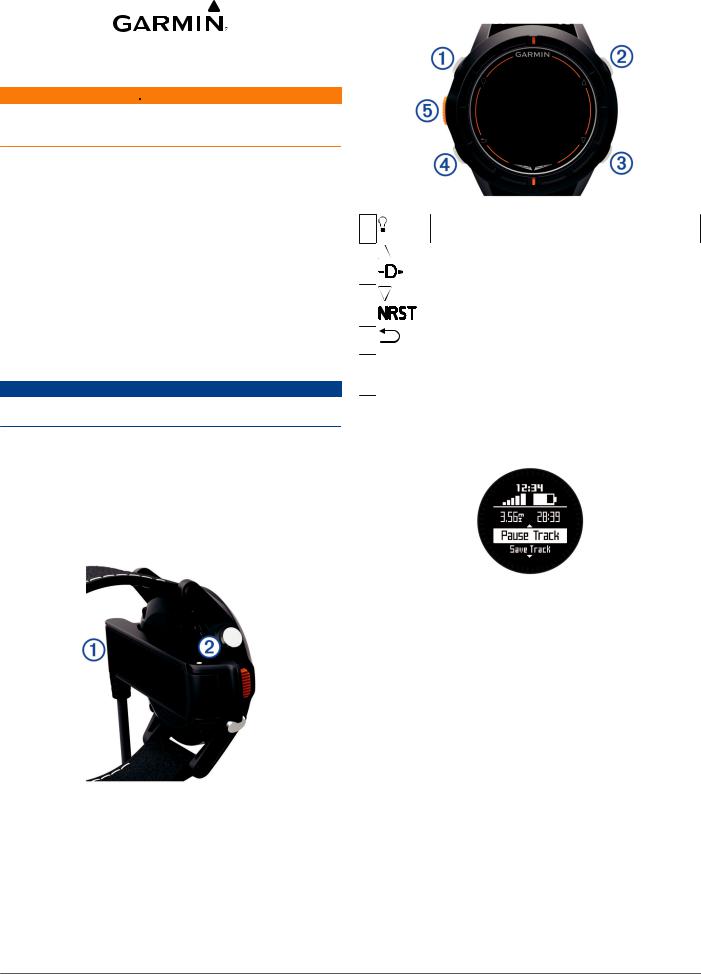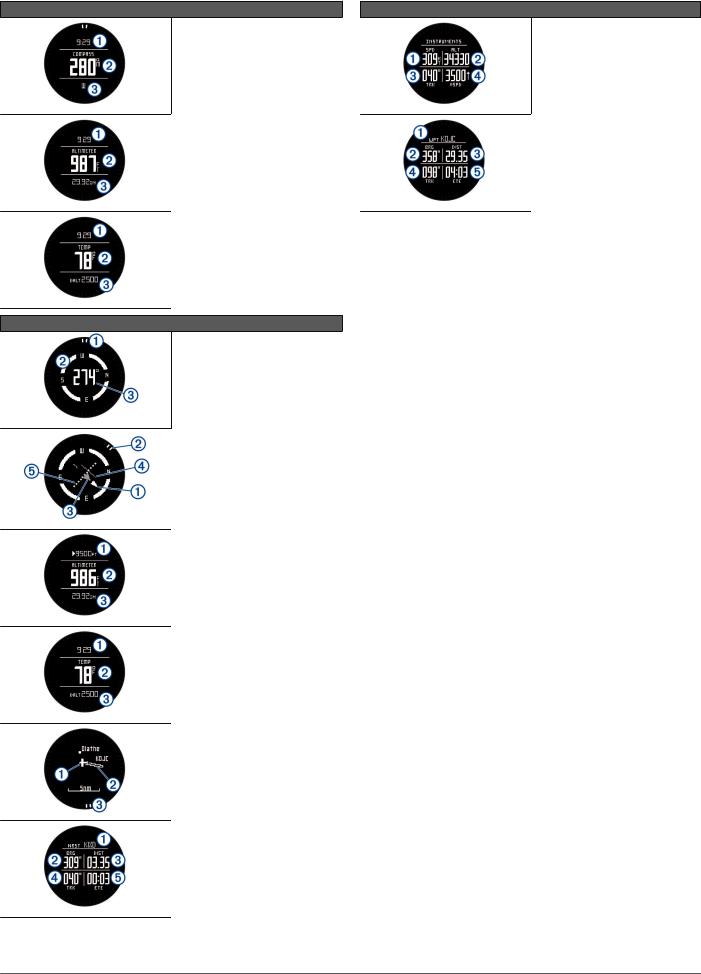Garmin D2 User Manual

Keys
D2™ Pilot Watch Quick Start Manual
 WARNING
WARNING
See the Important Safety and Product Information guide in the product box for product warnings and other important information.
Getting Started
When using your device the first time, you should complete these tasks to set up the device and get to know the basic features.
1 Charge the device (Charging the Device).
2 Register the device (Registering Your Device).
3Learn about the sensor data and modes (Viewing the Data Pages).
4Acquire satellites and record a track (Acquiring Satellite Signals and Recording a Track).
5 Create a waypoint (Creating a Waypoint).
6 Get the owner's manual (Getting the Owner's Manual).
Charging the Device
NOTICE
To prevent corrosion, thoroughly dry the contacts and the surrounding area before charging or connecting to a computer.
The device is powered by a built-in lithium-ion battery that you can charge using a standard wall outlet or a USB port on your computer.
1Plug the USB end of the cable into the AC adapter or a computer USB port.
2 Plug the AC adapter into a standard wall outlet.
3 Align the left side of the charging cradle with the groove on
À
the left side of the device.
4 Align the hinged side of the charger with the contacts on
Á
the back of the device.
When you connect the device to a power source, the device turns on.
5 Charge the device completely.
À |
Select to turn the backlight on and off. Hold to turn the |
|
device on and off. |
Select to scroll through the data pages, options, and
Á
settings. Hold to navigate to an airport by airport code (Navigating to an Airport by Identifier).
Select to scroll through the data pages, options, and
Â
settings. Hold to navigate to the nearest airport (Navigating to the Nearest Airport).
Select to return to the previous screen. Hold to view the
Ã
status page.
Action key Select to open the menu for the current screen. Select
Ä
to choose an option and to acknowledge a message. Hold to mark a waypoint.
Viewing the Status Page
You can quickly switch to this page to view the time of day, battery life, and GPS status information from any other page.
Hold  .
.
Viewing the Data Pages
Customizable data pages allow you to quickly access real-time data from internal and connected sensors. When you begin tracking or navigating, additional data pages appear.
From the time of day page, select  or
or  to cycle through the data pages.
to cycle through the data pages.
Data Pages
The data pages available on your device vary based on the device mode. In low power mode, GPS is disabled, and the device does not record data. In tracking mode, GPS is enabled and sensor data is recorded to the track log, but you are not navigating to a destination. In navigation mode, you are navigating to a destination.
NOTE: Your body temperature affects the temperature and density altitude. To get the most accurate temperature reading, remove the device from your wrist and wait 20–30 minutes.
March 2014 |
190-01674-01_0B |
Printed in Taiwan |

Low Power Mode
The compass page displays the time of day , direction of travel in
À
degrees , and cardinal direction
Á
.
Â
The altimeter page displays the time of day , pressure altitude
À
, and barometric pressure .
Á Â
The temperature page displays the
time of day , temperature ,
À Á and density altitude .
Â
Tracking or Navigation Modes
The compass page displays the bearing to the nearest airport ,
À
compass ring , and direction of
Á
travel in degrees (tracking
Â
mode only).
The horizontal situation indicator (HSI) displays the course line pointer , bearing to the next
À
waypoint , to-and-from indicator
Á
, and course deviation indicator
Â
(CDI) . The dots indicate the
à Ä
distance of deviation (navigation mode only).
The altimeter page displays the alert altitude (Setting the
À
Altitude Alert), pressure altitude , and barometric pressure .
Á Â
The temperature page displays the
time of day , temperature ,
À Á and density altitude .
Â
The map displays your current location and direction , the route
À
to your next waypoint , and the
Á
bearing to your next waypoint .
Â
The nearest airport page displays the airport identifier , bearing to
À
the airport , distance to the
Á
airport , track over ground ,
 à and the estimated time to the
airport .
Ä
Tracking or Navigation Modes
The instruments page displays
your ground speed , altitude ,
À Á track over ground , and the
Â
vertical speed in feet per minute
.
Ã
The next waypoint page displays the waypoint name , bearing to
À
the waypoint , distance to the
Á
waypoint , track over ground ,
 à and the estimated time to the next
waypoint (navigation mode
Ä
only).
Acquiring Satellite Signals and Recording a Track
Before you can use the GPS navigation features, such as recording a track, you must acquire satellite signals.
The time and date are set automatically based on the GPS position.
1 Select the action key.
2 Select Start GPS.
3Go to an area with a clear view of the sky and remain stationary while the device acquires satellite signals.
 indicates the device acquired satellite signals successfully.
indicates the device acquired satellite signals successfully.
4Walk around or travel to record a track. Your distance and time appear.
5 Select  to view the loop of data pages. 6 Hold
to view the loop of data pages. 6 Hold  .
.
7Select an option:
•Select Pause Track to pause tracking.
•Select Save Track to save your track.
•Select Clear Track to erase the track without saving.
•Select Stop GPS to turn off GPS without deleting your track.
Stopping GPS
1 Select the action key.
2 Select Stop GPS.
Setting the Altitude Alert
You can set an alarm to vibrate when you reach a specified altitude.
NOTE: The altitude alert is not available in low power mode.
1From the time of day page, select  until the altimeter page appears.
until the altimeter page appears.
2 Select the action key.
3 Select Set Alert.
4 Enter the altitude at which the alert is triggered.
Setting the Barometric Pressure
You can manually enter the current barometric pressure. This can help to improve the accuracy of the pressure altitude reading.
1From the time of day page, select  until the altimeter page appears.
until the altimeter page appears.
2 Select the action key.
3 Select Set Baro..
4 Enter the current barometric pressure.
2
